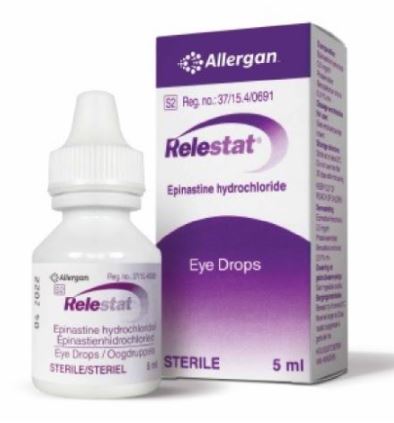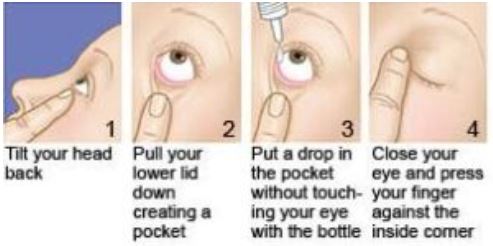
What is Relestat and What does it contain?
The active substance in Relestat is epinastine hydrochloride. 1 ml of eye drop solution contains 0.5 mg of epinastine hydrochloride. The other ingredients are benzalkonium chloride 0,01% m/v (a preservative), disodium edetate, sodium chloride, sodium dihydrogen phosphate dehydrate and purified water.
Pharmacodynamics of Epinastine Hydrochloride
Epinastine is a topically active, direct H1-receptor antagonist and an inhibitor of the release of histamine from the mast cell. Epinastine is selective for the histamine H1-receptor and has an affinity for the histamine H2 receptor. It also possesses an affinity for the α1-, α2-, and 5-HT2 –receptors. Epinastine does not penetrate the blood/brain barrier and, therefore, is not expected to induce side effects on the central nervous system.
Pharmacokinetics of Epinastine Hydrochloride
According to a study done by Allergan, manufacturers of Relestat, fourteen subjects, with allergic conjunctivitis, received one drop of epinastine Hydrochloride in each eye twice daily for seven days. On day seven, average maximum epinastine plasma concentrations of 0.04 ±0.014 ng/ml were reached after about two hours indicating low systemic exposure. The total systemic clearance is approximately 56 L/hr and the terminal plasma elimination half-life is about 12 hours. Epinastine is mainly excreted unchanged. About 55% of an intravenous dose is recovered unchanged in the urine with about 30% in feces. Less than 10% is metabolized.
Indications and Usage
Relestat is an eye drop that helps to alleviate symptoms associated with seasonal allergic conjunctivitis—a condition characterized by seasonal allergies affecting the eyes. The primary symptoms targeted by Relestat include watery eyes, along with itching, redness, or swelling of the eyes or eyelids.
Before You Apply Relestat Eye Drops
Do not use Relestat: If you are allergic (hypersensitive) to epinastine hydrochloride, benzakonium chloride, or any of the other ingredients.
Relestat and Contact Lenses: If you wear soft contact lenses (also called hydrophilic lenses), you must remove them before instilling Relestat eye drops. After using instillation, wait at least 15 minutes before putting your contact lenses back in. The preservative, called benzalkonium chloride can discolor soft contact lenses and may cause eye irritation.
If you have to apply other eye drop(s) or drugs together with Relestat: Wait for at least 10 minutes after applying Relestat before you instill the other drops. If your doctor indicates that the other eye drops need to be applied first then you still wait for 5-10 minutes before applying Relestat. Always tell your healthcare professional if you are taking any other medicine (this includes complementary or traditional medicines).
Pregnancy and breast-feeding: Relestat should not be used if you are pregnant or breastfeeding your baby. It is not known whether the drug passes into breast milk. If you are using Relestat you should not breastfeed your baby. If you are pregnant or breastfeeding your baby, please consult your doctor, pharmacist or other healthcare professional for advice before using Relestat.
Driving and using machinery: Your sight may become blurred for a short time just after using Relestat. You should not drive or use machines until your sight is clear again.
How to Apply Relestat
Instructions for use
- Wash your hands before opening the bottle. Tilt your head back and look at the ceiling
- Gently pull the lower eyelid down until there is a small “pocket”.
- Turn the bottle upside down and squeeze it to release one drop into each eye that needs treatment.
- Let go of the lower lid, and close your eyes for 30 seconds while pressing gently the inner side of your eye (between the eye and nose).

To avoid contamination of the solution in the bottle, do not let the tip of the bottle touch your eye or anything else. Replace and tighten the cap straight after use. Wipe off any excess liquid from your cheek with a clean tissue. You must not use the bottle if the tamper-proof seal on the bottle neck is broken before you first begin to use it.
Do not share medicines prescribed for you with any other person. Always use Relestat exactly as your doctor or pharmacist has instructed you. The proper application of your eye drops is very important. If you feel like the effect of the Relestat is too strong or too weak for you, tell your doctor or pharmacist.
Adults and adolescents (12 years of age and older)
Relestat should not be used in children below 12 years of age. The usual dose of Relestat is 1 drop in each eye that needs treatment, twice a day, for example in the morning and in the evening, usually for a month but not for longer than 8 weeks. You should use RELESTAT every day that you experience eye symptoms during the allergy season.
If you use more Relestat than you should (Overdosing)
If you use more drops of Relestat than you should, it is unlikely to cause you any harm. Put your next drop(s) in at the usual time. In the event of overdosage, consult your doctor or pharmacist. If neither is available, contact the nearest hospital or poison control centre.
If you forget to use Relestat
In situations where you forgot a dose, apply it as soon as you remember, unless it is almost time for your next dose, in which case you should miss out on the forgotten dose then use your next dose at the usual time and continue with your normal routine. Do not use a double dose to make up for a forgotten dose.
Side Effects of Relestat
Should your general health worsen or if you experience any untoward effects while using Relestat, please consult your doctor, pharmacist or other healthcare professional for advice.
Severe Side Effects
If any of the following happens, stop using Relestat and tell your doctor immediately or go to the casualty department at your nearest hospital:
- Severe allergic (hypersensitive) reaction with symptoms such as skin rash, which can be red and itchy, swelling of the eyes, throat or face;
- Asthma (an allergic disease affecting the lungs that causes breathing These are all very serious side effects. If you have them, you may have had a serious allergic reaction to RELESTAT. You may need urgent medical attention or hospitalization.
The following side effects may also occur:
General side effects:
- Headache
- Swelling and irritation inside the nose, which may cause a runny or blocked nose and sneezing
- Sinus Infection
- Unusual taste in your mouth
Side effects affecting the eye:
- Burning sensation or irritation of the eye (mostly mild)
- Red eyes
- Dry eyes
- Itchy eyes
- Difficulty in seeing clearly
- Discharge from the eyes
- Ocular hyperemia
- Lacrimation increased
- Eye pain
- Eye swelling
- Eyelid oedema
Patients have also reported the following side effects:
Immune system disorders, hypersensitivity reaction including symptoms or signs of eye allergy and skin allergic reaction. If you notice any side effects not mentioned in this leaflet, please inform your doctor or pharmacist.
Storing And Disposing
Store at or below 25 °C. Do not use the eye drops more than 30 days after opening.
Store all medicines out of reach of children. Do not use the medicine after the expiry date printed on the bottle and the box. Return all unused medicine to your pharmacist. Do not dispose of unused medicine in drains and sewerage systems (e.g. toilets).
How Does Relestat Eyedrop Look Like
5ml LDPE bottle with a dropper insert and a white polystyrene screw cap. Relestat is a clear and colourless eye drop solution in a multi-dose bottle with a screw cap.


